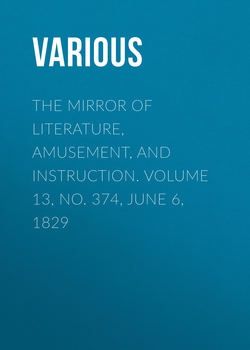The Mirror of Literature, Amusement, and Instruction. Volume 13, No. 374, June 6, 1829

Реклама. ООО «ЛитРес», ИНН: 7719571260.
Оглавление
Various. The Mirror of Literature, Amusement, and Instruction. Volume 13, No. 374, June 6, 1829
HOLLAND HOUSE, KENSINGTON
FIELD OF FORTY STEPS
ITALIAN IMPROVISATRI
I'LL COME TO YOUR BALL
THE SANJAC-SHERIF, OR STANDARD OF MAHOMET
EATING
THE SKETCH-BOOK
COWES REGATTA
MANNERS & CUSTOMS OF ALL NATIONS
ELEPHANT HUNT
BRAZILIAN SLAVE TRADE
OLD CHARING CROSS
NOTES OF A READER
ODD MISTAKE
FIGHT IN A CHURCH
SPANISH AND ITALIAN REFUGEES
RIVER MELODIES
REAL DISCONTENT
SOLIMAN "THE GREAT."
LONG SNOW
A GOOD BISHOP
AMERICAN COMFORTS
SPIRIT OF THE PUBLIC JOURNALS
THE GATHERER
"DRY LODGINGS TO LET."
SHAVING IN CHURCHYARDS
NOVEL HERALDRY
Отрывок из книги
Since the time of William III., who was the first royal tenant of the palace, Kensington has been a place of considerable interest, as the residence and resort of many celebrated men. The palace, however, possesses little historical attraction; but, among the mansions of the parish, Holland House merits especial notice.
Holland House takes its name from Henry Rich, Earl of Holland, and was built by his father-in-law, Sir Walter Cope, in the year 1607, of the architecture of which period it affords an excellent specimen. Its general form is that of an half H. The Earl of Holland greatly improved the house. The stone piers at the entrance of the court (over which are the arms of Rich, quartering Bouldry and impaling Cope) were designed by Inigo Jones. The internal decorations were by Francis Cleyne. One chamber, called the Gilt Room, which still remains in its original state, exhibits a very favourable specimen of the artist's abilities; the wainscot is in compartments, ornamented with cross crosslets and fleurs de-lis charges, in the arms of Rich and Cope, whose coats are introduced, entire, at the corner of the room, with a punning motto, alluding to the name of Rich, Ditior est qui se. Over the chimneys are some emblematical paintings, done (as the Earl of Orford observes) in a style and not unworthy of Parmegiane. The Earl of Holland was twice made a prisoner in his own house, first by King Charles, in 1633, upon occasion of his challenging Lord Weston; and a second time, by command of the parliament, after the unsuccessful issue of his attempt to restore the king, in August, 1648. The Earl, who was a conspicuous character during the whole of Charles's reign, and frequently in employments of considerable trust, appears to have been very wavering in his politics, and of an irritable disposition. In 1638, we find him retired to his house at Kensington, in disgust, because he was not made Lord Admiral. At the eve of the civil war, he was employed against the Scots; when the army was disbanded, having received some new cause of offence, he retired again to Kensington, where, according to Lord Clarendon, he was visited by all the disaffected members of parliament, who held frequent meetings at Holland House. Some time afterwards, when the civil war was at its height, he joined the king's party at Oxford; but, meeting with a cool reception, returned again to the parliament. In August 6, 1647, "the members of the parliament who were driven from Westminster by tumults, met General Fairfax at Holland House, and subscribed to the declaration of the army, and a further declaration, approving of and joining with the army, in all their late proceedings, making null all acts passed by the members since July 6." (Clarendon.)– The Earl of Holland's desertion of the royal cause, is to be attributed, perhaps, to his known enmity towards Lord Strafford; he gave, nevertheless, the best proof of his attachment to monarchy, by making a bold, though rash attempt, to restore his master. After a valiant stand against an unequal force, near Kingston upon Thames, he was obliged to quit the field, but was soon after taken prisoner, and suffered death upon the scaffold. His corpse was sent to Kensington, and interred in the family vault there, March 10, 1649. In the July following, Lambert, then general of the army, fixed his headquarters at Holland House. It was soon afterwards restored to the Countess of Holland. When theatres were shut up by the Puritans, plays were acted privately at the houses of the nobility, who made collections for the actors. Holland House is particularly mentioned, as having been used occasionally for this purpose.
.....
On the death of this young nobleman, in 1721, unmarried, his estates devolved to the father of Lord Kensington, (maternally descended from Robert Rich, Earl of Warwick.) who sold Holland House, about 1762, to the Right Hon. Henry Fox, afterwards Lord Holland, the early years of whose patriotic son, the late C.J. Fox, were passed chiefly at this mansion; and his nephew, the present Lord Holland, is now owner of the estate.
The apartments of Holland House, are, generally, capacious and well proportioned. The library is about 105 feet in length, and the collection of books is worthy of the well known literary taste of the noble proprietor. Here also are several fine busts by Nollekens, and a valuable collection of pictures by Sir Godfrey Kneller, Sir Joshua Reynolds, &c. two fine landscapes by Salvator Rosa, and a collection of exquisite miniatures.
.....